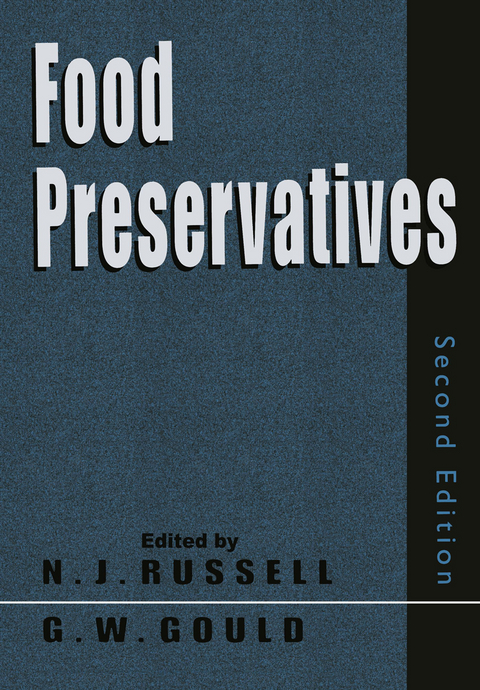
Food Preservatives
Springer-Verlag New York Inc.
978-1-4757-1006-9 (ISBN)
This book supports the continued safe and effective use of preservatives within these current constraints. It therefore gives detailed information on the practical use of the major antimicrobial preservatives. Uniquely, it couples this with current understanding of their modes of action, at the levels of cellular physiology and biochemistry, in such a way as to provide a sound scientific basis for their efficacy. Such an approach also encourages the future logical development and use of preservatives.
1 Major, new, and emerging food-poisoning and food-spoilage microorganisms.- 1.1 Introduction.- 1.2 Food-poisoning microorganisms.- 1.3 Food-spoilage microorganisms.- 1.4 Conclusions.- References.- 2 Major preservation technologies.- 2.1 Introduction.- 2.2 Basis of food preservation.- 2.3 Major food preservation techniques.- 2.4 Conclusions.- References.- 3 Acidulants and low pH.- 3.1 Introduction.- 3.2 Direct action of pH and acids on microorganisms.- 3.3 Acid as an indirect stress: consequences of lowering cytoplasmic pH.- 3.4 Acids in foods: the antimicrobial effectiveness of different acids.- 3.5 The relationship of pH to growth and survival.- 3.6 Acid-resistant food pathogens and spoilage microorganisms.- 3.7 Adaptation to low pH.- 3.8 Conclusions.- References.- 4 Organic acids and esters.- 4.1 Summary.- 4.2 Introduction.- 4.3 The use of organic acids and esters in foods.- 4.4 Chemical properties of organic acids and esters.- 4.5 General mechanisms of antimicrobial action.- 4.6 Organic acids as antimicrobial agents.- 4.7 Esters as antimicrobial agents.- 4.8 Adaptation and resistance by microorganisms.- 4.9 Conclusions.- References.- 5 Sulfite.- 5.1 Introduction.- 5.2 Uses in foods.- 5.3 Mode of action.- 5.4 Postscript.- References.- 6 Nitrite.- 6.1 Introduction.- 6.2 Sources of nitrates and nitrites.- 6.3 Health concerns with sodium nitrite in cured meats.- 6.4 Nitrate and nitrite metabolism.- 6.5 N-nitroso compound formation in cured meats.- 6.6 N-nitroso compounds and human health.- 6.7 Effect of additives and ingredients on nitrosamine formation.- 6.8 Regulation of nitrite in cured meats.- 6.9 Functions of nitrite in meat curing.- 6.10 Conclusions.- References.- 7 Solutes and low water activity.- 7.1 Introduction.- 7.2 Influence of water activity on microorganisms.- 7.3 Foods.- 7.4 Microbial response to low water activity: basic mechanisms.- 7.5 Combined factors.- References.- 8 Bacteriocins — Nisin.- 8.1 Introduction.- 8.2 Definition of nisin activity and nisin potency.- 8.3 Methods of assay.- 8.4 Stability and solubility.- 8.5 Antimicrobial spectrum.- 8.6 Mode of action.- 8.7 Factors affecting nisin action.- 8.8 Toxicological studies.- 8.9 Practical applications of nisin and food preservation.- 8.10 Genetics and maturation pathway of nisin.- 8.11 Protein engineering of nisin.- References.- 9 Natamycin.- 9.1 Introduction.- 9.2 Physical and chemical properties.- 9.3 Mechanism of action.- 9.4 Sensitivity of fungi to natamycin.- 9.5 Inhibition of mycotoxin formation by natamycin.- 9.6 Applications of natamycin.- 9.7 Regulatory food status of natamycin.- References.- 10 Ethanol as a food preservative.- 10.1 Introduction.- 10.2 Use of ethanol in food preservation.- 10.3 Anti-staling effects.- 10.4 Indirect use of ethanol in food technology.- 10.5 Synergy of ethanol and other antimicrobials.- 10.6 Antimicrobial mode of action.- 10.7 Legal considerations.- References.- 11 Modified atmospheres and vacuum packaging.- 11.1 Introduction.- 11.2 Gases used and their modes of action.- 11.3 Factors other than packaging affecting spoilage development.- 11.4 Non-microbial product deterioration.- 11.5 Packaging materials.- 11.6 Packaging machines.- 11.7 Microbial ecology.- 11.8 Microbial safety.- 11.9 Developments in MAP.- 11.10 Conclusions.- Acknowledgments.- References.- 12 Surface preservation for fruits and vegetables.- 12.1 Introduction.- 12.2 Factors affecting the quality of fruits and vegetables.- 12.3 Surface washing of fruits and vegetables.- 12.4 Surface preservatives for fruits and vegetables.- 12.5 Summary.- References.- 13Naturally occurring antimicrobial systems.- 13.1 Introduction.- 13.2 A systems approach to food preservation.- 13.3 Agents that damage microbial cell walls: lysozyme and other hydrolytic enzymes.- 13.4 Agents that perturb the physiology of microbial membranes: lactoperoxidase.- 13.5 Agents that impair microbial metabolism: iron chelators and avidin.- 13.6 Agents having a generalized and ill-defined role: plant extracts and phenolics.- 13.7 Future prospects.- Acknowledgments.- References.- 14 Starter and protective cultures.- 14.1 Introduction.- 14.2 Bacterial starters and protective cultures.- 14.3 Fungi in food processing.- 14.4 Future prospects and genetic optimization.- References.- 15 Legislative aspects.- 15.1 Introduction.- 15.2 Role of preservatives.- 15.3 Legislation of preservatives.- 15.4 Future trends in preservatives legislation.- References.- 16 Food preservatives — future prospects.- 16.1 Introduction.- 16.2 Stress response and virulence.- 16.3 Risk analysis.- 16.4 Some specific preservative issues.- References.
| Erscheint lt. Verlag | 12.12.2012 |
|---|---|
| Zusatzinfo | XVI, 380 p. |
| Verlagsort | New York, NY |
| Sprache | englisch |
| Maße | 178 x 254 mm |
| Themenwelt | Naturwissenschaften ► Biologie ► Biochemie |
| Naturwissenschaften ► Biologie ► Mikrobiologie / Immunologie | |
| Naturwissenschaften ► Chemie | |
| Technik ► Lebensmitteltechnologie | |
| ISBN-10 | 1-4757-1006-2 / 1475710062 |
| ISBN-13 | 978-1-4757-1006-9 / 9781475710069 |
| Zustand | Neuware |
| Informationen gemäß Produktsicherheitsverordnung (GPSR) | |
| Haben Sie eine Frage zum Produkt? |
aus dem Bereich


